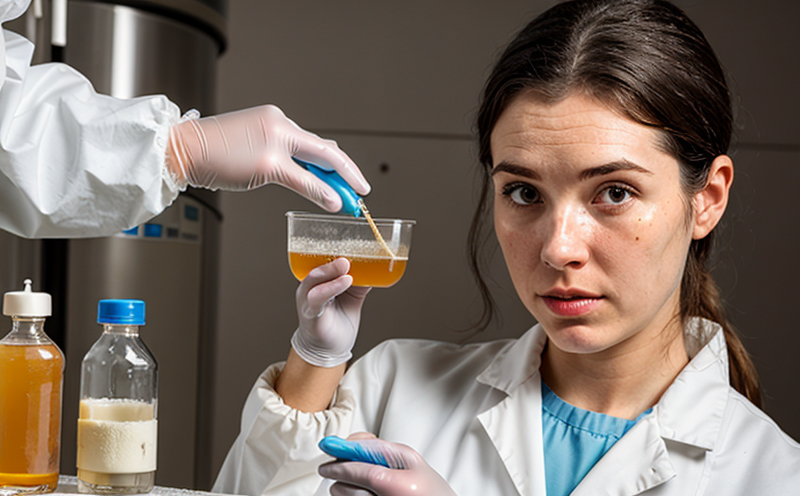WHO Foodborne Mycotoxin-Producing Mould Testing
The World Health Organization (WHO) has recognized mycotoxins as a significant global health concern, particularly in relation to food safety and public health. Among the various types of mycotoxins, those produced by molds can be especially harmful when ingested through contaminated food products. This service focuses on identifying mold species that have the potential to produce these toxins, ensuring stringent compliance with international standards.
The identification of mycotoxin-producing molds is critical in safeguarding public health and maintaining product integrity within the food industry. This testing involves a comprehensive approach that includes sample collection, preliminary analysis, isolation techniques, and confirmatory tests. Our laboratory employs advanced methodologies to detect the presence of these molds at extremely low levels, ensuring accuracy and reliability.
The process begins with the collection of samples from suspected sources such as grains, cereals, fruits, nuts, and other food products. Once collected, the specimens undergo a series of steps including drying, grinding, and homogenization to ensure consistency in testing. The mold is then isolated using selective media tailored for specific genera or species that are known to produce mycotoxins.
After isolation, the mold colony is further characterized through microscopic examination, biochemical tests, and molecular techniques such as DNA sequencing. These methods provide a high level of specificity necessary for accurate identification. The next step involves testing for the presence of mycotoxin-producing genes using quantitative PCR (qPCR) or similar assays. This ensures that not only are the molds identified but also their potential to produce harmful toxins.
Our laboratory adheres strictly to international standards such as ISO 16149 and AOAC Official Methods for mold identification and mycotoxin detection. Compliance with these guidelines ensures consistent, reliable results that can be trusted by regulatory bodies and industry stakeholders alike. The final report includes detailed information on the species identified, its potential toxicity, along with recommendations for mitigation strategies.
This service is particularly valuable for quality managers, compliance officers, R&D engineers, and procurement teams who need to ensure their products meet stringent food safety standards. By providing precise identification of mold species capable of producing mycotoxins, our lab helps prevent contamination risks that could lead to health issues among consumers.
Applied Standards
| Standard | Description |
|---|---|
| ISO 16149:2013 | Mold identification and enumeration in foods; culture-dependent method for filamentous fungi. |
| AOAC Official Method 997.15 | Method for the detection of aflatoxin B1 in corn, peanuts, and peanut butter by enzyme-linked immunosorbent assay (ELISA). |
| ECM 203-8 | Mold identification using microscopic examination. |
| AACC Method 56-49 | Determination of mold and yeast in cereal grains by culture method. |
| European Commission Regulation (EU) No 2073/2005 | Setting maximum levels for certain contaminants, including aflatoxins in foodstuffs. |
Industry Applications
The WHO Foodborne Mycotoxin-Producing Mould Testing service finds application across multiple sectors where food safety is paramount. For instance, in the agricultural sector, this test helps farmers and processors identify molds that may contaminate crops before they reach market shelves. In the pharmaceutical industry, it ensures that medicinal products derived from natural sources do not harbor harmful mold species.
In addition to these primary applications, our service also benefits supply chain management by providing data on potential contamination points along the distribution chain. This information allows companies to implement preventive measures early in the process, reducing the risk of recalls and protecting brand reputation. Furthermore, it supports regulatory compliance requirements set forth by bodies like the World Health Organization (WHO) and Food and Agriculture Organization (FAO).
For research and development departments within food manufacturing firms, our service offers insights into the prevalence of specific mold species in different regions worldwide. This knowledge can guide product formulation changes aimed at enhancing safety profiles while maintaining taste and texture preferences.
Quality and Reliability Assurance
At our laboratory, quality assurance is a cornerstone of every project we undertake. We maintain strict adherence to international standards such as ISO 17025 for proficiency testing programs and ISO/IEC 17026 for reference material production. Our team comprises highly qualified professionals with extensive experience in mycology and food safety.
Every stage of the testing process—from sample preparation to final report generation—is meticulously documented, ensuring transparency and traceability throughout the entire procedure. Regular internal audits and external accreditation reviews further reinforce our commitment to delivering accurate results consistently across all projects.
We invest heavily in state-of-the-art equipment and continuous training programs for our staff members. This investment ensures that we stay at the forefront of technological advancements without compromising on traditional methods known to yield reliable outcomes. By leveraging both modern technology and proven techniques, we offer clients peace of mind knowing their samples are being handled by experts who understand the nuances involved in identifying mycotoxin-producing molds.





